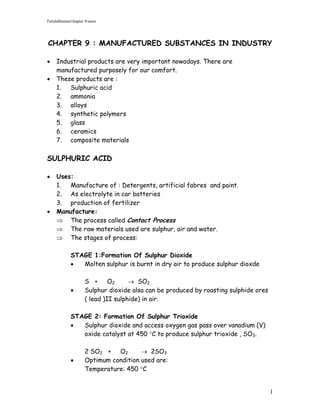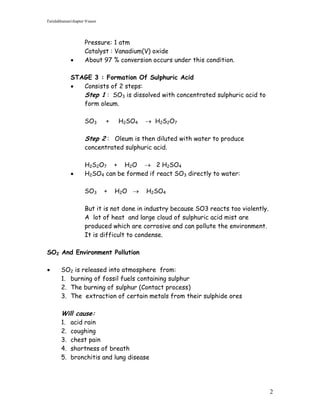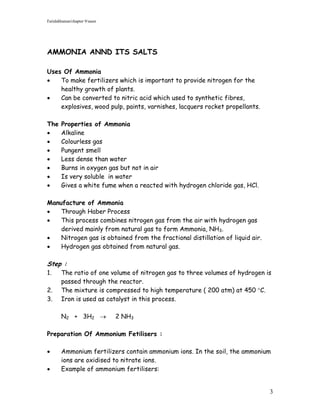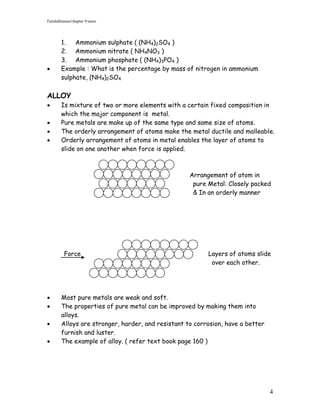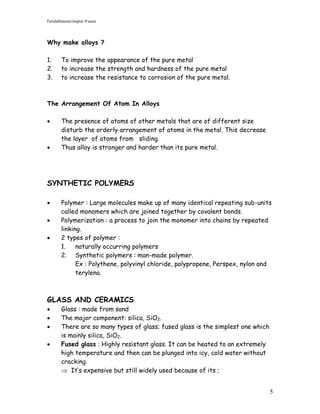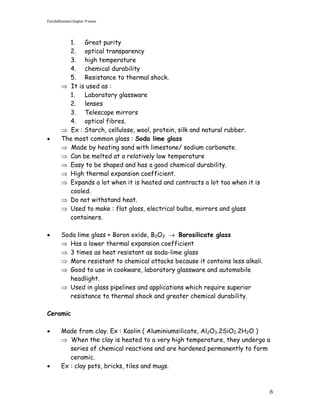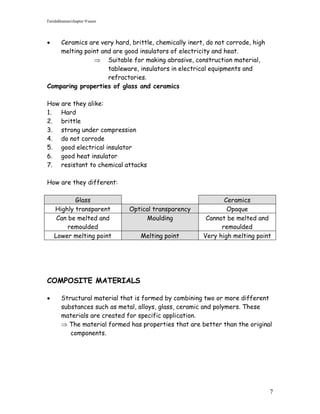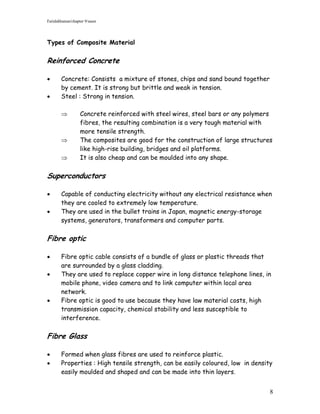Chapter 9 manufacture substances
- 1. Faridahhamat/chapter 9/saser CHAPTER 9 : MANUFACTURED SUBSTANCES IN INDUSTRY ’éĘ Industrial products are very important nowadays. There are manufactured purposely for our comfort. ’éĘ These products are : 1. Sulphuric acid 2. ammonia 3. alloys 4. synthetic polymers 5. glass 6. ceramics 7. composite materials SULPHURIC ACID ’éĘ Uses: 1. Manufacture of : Detergents, artificial fabres and paint. 2. As electrolyte in car batteries 3. production of fertilizer ’éĘ Manufacture: ’ā× The process called Contact Process ’ā× The raw materials used are sulphur, air and water. ’ā× The stages of process: STAGE 1:Formation Of Sulphur Dioxide ’éĘ Molten sulphur is burnt in dry air to produce sulphur dioxde S + O2 ’é« SO2 ’éĘ Sulphur dioxide alsa can be produced by roasting sulphide ores ( lead )II sulphide) in air. STAGE 2: Formation Of Sulphur Trioxide ’éĘ Sulphur dioxide and access oxygen gas pass over vanadium (V) oxide catalyst at 450 ’é░C to produce sulphur trioxide , SO3. 2 SO2 + O2 ’é« 2SO3 ’éĘ Optimum condition used are: Temperature: 450 ’é░C 1
- 2. Faridahhamat/chapter 9/saser Pressure: 1 atm Catalyst : Vanadium(V) oxide ’éĘ About 97 % conversion occurs under this condition. STAGE 3 : Formation Of Sulphuric Acid ’éĘ Consists of 2 steps: Step 1 : SO3 is dissolved with concentrated sulphuric acid to form oleum. SO3 + H2SO4 ’é« H2S2O7 Step 2 : Oleum is then diluted with water to produce concentrated sulphuric acid. H2S2O7 + H2O ’é« 2 H2SO4 ’éĘ H2SO4 can be formed if react SO3 directly to water: SO3 + H2O ’é« H2SO4 But it is not done in industry because SO3 reacts too violently. A lot of heat and large cloud of sulphuric acid mist are produced which are corrosive and can pollute the environment. It is difficult to condense. SO2 And Environment Pollution ’éĘ SO2 is released into atmosphere from: 1. burning of fossil fuels containing sulphur 2. The burning of sulphur (Contact process) 3. The extraction of certain metals from their sulphide ores Will cause: 1. acid rain 2. coughing 3. chest pain 4. shortness of breath 5. bronchitis and lung disease 2
- 3. Faridahhamat/chapter 9/saser AMMONIA ANND ITS SALTS Uses Of Ammonia ’éĘ To make fertilizers which is important to provide nitrogen for the healthy growth of plants. ’éĘ Can be converted to nitric acid which used to synthetic fibres, explosives, wood pulp, paints, varnishes, lacquers rocket propellants. The Properties of Ammonia ’éĘ Alkaline ’éĘ Colourless gas ’éĘ Pungent smell ’éĘ Less dense than water ’éĘ Burns in oxygen gas but not in air ’éĘ Is very soluble in water ’éĘ Gives a white fume when a reacted with hydrogen chloride gas, HCl. Manufacture of Ammonia ’éĘ Through Haber Process ’éĘ This process combines nitrogen gas from the air with hydrogen gas derived mainly from natural gas to form Ammonia, NH3. ’éĘ Nitrogen gas is obtained from the fractional distillation of liquid air. ’éĘ Hydrogen gas obtained from natural gas. Step : 1. The ratio of one volume of nitrogen gas to three volumes of hydrogen is passed through the reactor. 2. The mixture is compressed to high temperature ( 200 atm) at 450 ’é░C. 3. Iron is used as catalyst in this process. N2 + 3H2 ’é« 2 NH3 Preparation Of Ammonium Fetilisers : ’éĘ Ammonium fertilizers contain ammonium ions. In the soil, the ammonium ions are oxidised to nitrate ions. ’éĘ Example of ammonium fertilisers: 3
- 4. Faridahhamat/chapter 9/saser 1. Ammonium sulphate ( (NH4)2SO4 ) 2. Ammonium nitrate ( NH4NO3 ) 3. Ammonium phosphate ( (NH4)3PO4 ) ’éĘ Example : What is the percentage by mass of nitrogen in ammonium sulphate, (NH4)2SO4 ALLOY ’éĘ Is mixture of two or more elements with a certain fixed composition in which the major component is metal. ’éĘ Pure metals are make up of the same type and same size of atoms. ’éĘ The orderly arrangement of atoms make the metal ductile and malleable. ’éĘ Orderly arrangement of atoms in metal enables the layer of atoms to slide on one another when force is applied. Arrangement of atom in pure Metal: Closely packed & In an orderly manner Force Layers of atoms slide over each other. ’éĘ Most pure metals are weak and soft. ’éĘ The properties of pure metal can be improved by making them into alloys. ’éĘ Alloys are stronger, harder, and resistant to corrosion, have a better furnish and luster. ’éĘ The example of alloy. ( refer text book page 160 ) 4
- 5. Faridahhamat/chapter 9/saser Why make alloys ? 1. To improve the appearance of the pure metal 2. to increase the strength and hardness of the pure metal 3. to increase the resistance to corrosion of the pure metal. The Arrangement Of Atom In Alloys ’éĘ The presence of atoms of other metals that are of different size disturb the orderly arrangement of atoms in the metal. This decrease the layer of atoms from sliding. ’éĘ Thus alloy is stronger and harder than its pure metal. SYNTHETIC POLYMERS ’éĘ Polymer : Large molecules make up of many identical repeating sub-units called monomers which are joined together by covalent bonds. ’éĘ Polymerization : a process to join the monomer into chains by repeated linking. ’éĘ 2 types of polymer : 1. naturally occurring polymers 2. Synthetic polymers : man-made polymer. Ex : Polythene, polyvinyl chloride, polypropene, Perspex, nylon and terylena. GLASS AND CERAMICS ’éĘ Glass : made from sand ’éĘ The major component: silica, SiO2. ’éĘ There are so many types of glass; fused glass is the simplest one which is mainly silica, SiO2. ’éĘ Fused glass : Highly resistant glass. It can be heated to an extremely high temperature and then can be plunged into icy, cold water without cracking. ’ā× ItŌĆÖs expensive but still widely used because of its ; 5
- 6. Faridahhamat/chapter 9/saser 1. Great purity 2. optical transparency 3. high temperature 4. chemical durability 5. Resistance to thermal shock. ’ā× It is used as : 1. Laboratory glassware 2. lenses 3. Telescope mirrors 4. optical fibres. ’ā× Ex : Starch, cellulose, wool, protein, silk and natural rubber. ’éĘ The most common glass : Soda lime glass ’ā× Made by heating sand with limestone/ sodium carbonate. ’ā× Can be melted at a relatively low temperature ’ā× Easy to be shaped and has a good chemical durability. ’ā× High thermal expansion coefficient. ’ā× Expands a lot when it is heated and contracts a lot too when it is cooled. ’ā× Do not withstand heat. ’ā× Used to make : flat glass, electrical bulbs, mirrors and glass containers. ’éĘ Soda lime glass + Boron oxide, B2O3 ’é« Borosilicate glass ’ā× Has a lower thermal expansion coefficient ’ā× 3 times as heat resistant as soda-lime glass ’ā× More resistant to chemical attacks because it contains less alkali. ’ā× Good to use in cookware, laboratory glassware and automobile headlight. ’ā× Used in glass pipelines and applications which require superior resistance to thermal shock and greater chemical durability. Ceramic ’éĘ Made from clay. Ex : Kaolin ( Aluminiumsilicate, Al2O3.2SiO2.2H2O ) ’ā× When the clay is heated to a very high temperature, they undergo a series of chemical reactions and are hardened permanently to form ceramic. ’éĘ Ex : clay pots, bricks, tiles and mugs. 6
- 7. Faridahhamat/chapter 9/saser ’éĘ Ceramics are very hard, brittle, chemically inert, do not corrode, high melting point and are good insulators of electricity and heat. ’ā× Suitable for making abrasive, construction material, tableware, insulators in electrical equipments and refractories. Comparing properties of glass and ceramics How are they alike: 1. Hard 2. brittle 3. strong under compression 4. do not corrode 5. good electrical insulator 6. good heat insulator 7. resistant to chemical attacks How are they different: Glass Ceramics Highly transparent Optical transparency Opaque Can be melted and Moulding Cannot be melted and remoulded remoulded Lower melting point Melting point Very high melting point COMPOSITE MATERIALS ’éĘ Structural material that is formed by combining two or more different substances such as metal, alloys, glass, ceramic and polymers. These materials are created for specific application. ’ā× The material formed has properties that are better than the original components. 7
- 8. Faridahhamat/chapter 9/saser Types of Composite Material Reinforced Concrete ’éĘ Concrete: Consists a mixture of stones, chips and sand bound together by cement. It is strong but brittle and weak in tension. ’éĘ Steel : Strong in tension. ’ā× Concrete reinforced with steel wires, steel bars or any polymers fibres, the resulting combination is a very tough material with more tensile strength. ’ā× The composites are good for the construction of large structures like high-rise building, bridges and oil platforms. ’ā× It is also cheap and can be moulded into any shape. Superconductors ’éĘ Capable of conducting electricity without any electrical resistance when they are cooled to extremely low temperature. ’éĘ They are used in the bullet trains in Japan, magnetic energy-storage systems, generators, transformers and computer parts. Fibre optic ’éĘ Fibre optic cable consists of a bundle of glass or plastic threads that are surrounded by a glass cladding. ’éĘ They are used to replace copper wire in long distance telephone lines, in mobile phone, video camera and to link computer within local area network. ’éĘ Fibre optic is good to use because they have law material costs, high transmission capacity, chemical stability and less susceptible to interference. Fibre Glass ’éĘ Formed when glass fibres are used to reinforce plastic. ’éĘ Properties : High tensile strength, can be easily coloured, low in density easily moulded and shaped and can be made into thin layers. 8
- 9. Faridahhamat/chapter 9/saser ’éĘ Used to make household products like water storage tanks, badminton rackets, small boats, skis and helmets. Photochromic Glass ’éĘ Produced by embedding photochromic substances like silver chloride, AgCl crystals in glass or transparent polymers. ’éĘ Used for making optical lenses, car windshields, smart energy efficient windows in buildings, information display panels, lense in cameras, optical switches and light intensity meters. 9
